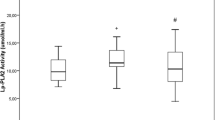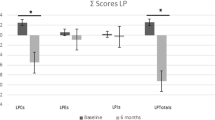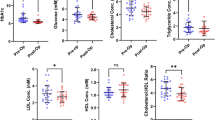Abstract
Obesity is associated with lipid abnormalities leading to an increased morbidity and mortality from atherosclerotic disease. Lipid transfer proteins such as Cholesteryl Ester Transfer Protein (CETP) and Phospholipid Transfer Protein (PLTP), and lipases such as lipoprotein lipase (LPL) and hepatic lipase (HL) are involved in the pathogenesis of the obesity associated proatherogenic dyslipidemia. Nineteen severely obese female subjects undergoing laparosopic gastric banding participated in this prospective study. Subjects were examined with respect to body composition, lipid profile, CETP, PLTP, LPL and HL before and 1 year after surgical treatment. Mean weight loss was 22.2 kg, mainly due to losses in the fat depots. Triglycerides decreased and HDL2-C increased significantly. In respect to transfer proteins mean CETP mass decreased from 1.82 to 1.71 μg mL−1 (P = 0.043) and mean PLTP activity was reduced from 7.15 to 6.12 μmol mL−1 h−1 (P = 0.002), in parallel. In addition, both mean LPL activity and mean HL activity tended to decrease from 297 to 248 nmol mL−1 h−1 for LPL (P = 0.139) and from 371 to 319 nmol mL−1 h−1 for HL (P = 0.170), respectively. We conclude that weight loss induced by bariatric surgery is associated with the amelioration of the obesity-associated dyslipidemic state. This improvement may be attributable to decreased mass and action of the adipocyte tissue derived lipid transfer proteins CETP and PLTP.
Similar content being viewed by others
Abbreviations
- CE:
-
Cholesteryl esters
- CETP:
-
Cholesteryl ester transfer protein
- HDL:
-
High density lipoprotein
- HL:
-
Hepatic lipase
- LAGB:
-
Laparoscopic adjustable gastric banding
- LDL:
-
Low density lipoprotein
- LPL:
-
Lipoprotein lipase
- PLTP:
-
Phospholipid transfer protein
- VLDL:
-
Very low-density lipoprotein
References
Stevens J, Cai J, Pamuk ER, Williamson DF, Thun MJ, Wood JL (1998) The effect of age on the association between body-mass index and mortality. N Engl J Med 338:1–7
Lamon-Fava S, Wilson PW, Schaefer EJ (1996) Impact of body mass index on coronary heart disease risk factors in men and women. The Framingham Offspring Study. Arterioscler Thromb Vasc Biol 16:1509–1515
Kannel WB, Cupples LA, Ramaswami R, Stokes J, Kreger BE, Higgins M (1991) Regional obesity and risk of cardiovascular disease; the Framingham Study. J Clin Epidemiol 44:183–190
Dusserre E, Moulin P, Vidal H (2000) Differences in mRNA expression of the proteins secreted by the adipocytes in human subcutaneous and visceral adipose tissues. Biochim Biophys Acta 1500:88–96
Arai T, Yamashita S, Hirano K, Sakai N, Kotani K, Fujioka S, Nozaki S, Keno Y, Yamane M, Shinohara E et al (1994) Increased plasma cholesteryl ester transfer protein in obese subjects. A possible mechanism for the reduction of serum HDL cholesterol levels in obesity. Arterioscler Thromb 14:1129–1136
Dullaart RP, Sluiter WJ, Dikkeschei LD, Hoogenberg K, Van Tol A (1994) Effect of adiposity on plasma lipid transfer protein activities: a possible link between insulin resistance and high density lipoprotein metabolism. Eur J Clin Invest 24:188–194
Ebenbichler C, Kirchmair R, Egger C, Patsch JR (1995) Postprandial lipemia and atherosclerosis. Curr Opin Lipidol 6:286–290
Ebenbichler CF, Laimer M, Kaser S, Ritsch A, Sandhofer A, Weiss H, Aigner F, Patsch JR (2002) Relationship between cholesteryl ester transfer protein and the atherogenic lipoprotein profile in morbidly obese women. Arterioscler Thromb Vasc Biol 22:1465–1469
Ritsch A, Patsch JR (2003) Cholesteryl ester transfer protein: gathering momentum as a genetic marker and as drug target. Curr Opin Lipidol 14:173–179
Jauhiainen M, Metso J, Pahlman R, Blomqvist S, Tol A, Ehnholm C (1993) Human plasma phospholipid transfer protein causes high density lipoprotein conversion. J Biol Chem 268:4032–4036
Jiang XC, Moulin P, Quinet E, Goldberg IJ, Yacoub LK, Agellon LB, Compton D, Schnitzer-Polokoff R, Tall AR (1991) Mammalian adipose tissue and muscle are the major source of lipid transfer protein mRNA. J Biol Chem 266:4631–4639
Jiang XC, Bruce C, Mar J, Lin M, Ji Y, Francone OL, Tall AR (1999) Targeted mutation of plasma phospholipid transfer protein gene markedly reduces high-density lipoprotein levels. J Clin Invest 103:907–914
Schlitt A, Bickel C, Thumma P, Blankenberg S, Rupprecht HJ, Meyer J, Jiang XC (2003) High plasma phospholipid transfer protein levels as a risk factor for coronary artery disease. Arterioscler Thromb Vasc Biol 23:1857–1862
Kaser S, Laimer M, Sandhofer A, Salzmann K, Ebenbichler CF, Patsch JR (2004) Effects of weight loss on PLTP activity and HDL particle size. Int J Obes Relat Metab Disord 28:1280–1282
Zambon A, Bertocco S, Vitturi N, Polentarutti V, Vianello D, Crepaldi G (2003) Relevance of hepatic lipase to the metabolism of triacylglycerol-rich lipoproteins. Biochem Soc Trans 31:1070–1074
Deeb SS, Zambon A, Carr MC, Ayyobi AF, Brunzell JD (2003) Hepatic lipase and dyslipidemia: interactions among genetic variants, obesity, gender, and diet. J Lipid Res 44:1279–1286
Cohen JC, Vega GL, Grundy SM (1999) Hepatic lipase: new insights from genetic and metabolic studies. Curr Opin Lipidol 10:259–267
Purnell JQ, Kahn SE, Albers JJ, Nevin DN, Brunzell JD, Schwartz RS (2000) Effect of weight loss with reduction of intra-abdominal fat on lipid metabolism in older men. J Clin Endocrinol Metab 85:977–982
Preiss-Landl K, Zimmermann R, Hammerle G, Zechner R (2002) Lipoprotein lipase: the regulation of tissue specific expression and its role in lipid and energy metabolism. Curr Opin Lipidol 13:471–481
Forsell P, Hallberg D, Hellers G (1993) Gastric banding for morbid obesity: initial experience with a new adjustable band. Obes Surg 3:369–374
Mittermair RP, Weiss H, Nehoda H, Kirchmayr W, Aigner F (2003) Laparoscopic Swedish adjustable gastric banding: 6-year follow-up and comparison to other laparoscopic bariatric procedures. Obes Surg 13:412–417
Patsch W, Brown SA, Morrisett JD, Gotto AM Jr, Patsch JR (1989) A dual-precipitation method evaluated for measurement of cholesterol in high-density lipoprotein subfractions HDL2 and HDL3 in human plasma. Clin Chem 35:265–270
Friedewald WT, Levy RI, Fredrickson DS (1972) Estimation of the concentration of low-density lipoprotein cholesterol in plasma, without use of the preparative ultracentrifuge. Clin Chem 18:499–502
Ritsch A, Ebenbichler C, Naschberger E, Schgoer W, Stanzl U, Dietrich H, Heinrich PC, Saito K, Patsch JR (2004) Phage-displayed recombinant single-chain antibody fragments with high affinity for cholesteryl ester transfer protein (CETP): cDNA cloning, characterization and CETP quantification. Clin Chem Lab Med 42:247–255
Ritsch A, Auer B, Föger B, Schwarz S, Patsch JR (1993) Polyclonal antibody-based immunoradiometric assay for quantification of cholesteryl ester transfer protein. J Lipid Res 34:673–679
Kaser S, Ebenbichler CF, Wolf HJ, Sandhofer A, Stanzl U, Ritsch A, Patsch JR (2001) Lipoprotein profile and cholesteryl ester transfer protein in neonates. Metabolism 50:723–728
Kaser S, Sandhofer A, Foger B, Ebenbichler CF, Igelseder B, Malaimare L, Paulweber B, Patsch JR (2001) Influence of obesity and insulin sensitivity on phospholipid transfer protein activity. Diabetologia 44:1111–1117
Deckelbaum RJ, Hamilton JA, Moser A, Bengtsson-Olivecrona G, Butbul E, Carpentier YA, Gutman A, Olivecrona T (1990) Medium-chain versus long-chain triacylglycerol emulsion hydrolysis by lipoprotein lipase and hepatic lipase: implications for the mechanisms of lipase action. Biochemistry 29:1136–1142
Eriksson JW, Buren J, Svensson M, Olivecrona T, Olivecrona G (2003) Postprandial regulation of blood lipids and adipose tissue lipoprotein lipase in type 2 diabetes patients and healthy control subjects. Atherosclerosis 166:359–367
Sampalis JS, Liberman M, Auger S, Christou NV (2004) The impact of weight reduction surgery on health-care costs in morbidly obese patients. Obes Surg 14:939–947
Sjostrom L, Lindroos AK, Peltonen M, Torgerson J, Bouchard C, Carlsson B, Dahlgren S, Larsson B, Narbro K, Sjostrom CD, Sullivan M, Wedel H (2004) Lifestyle, diabetes, and cardiovascular risk factors 10 years after bariatric surgery. N Engl J Med 351:2683–2693
Murdoch SJ, Kahn SE, Albers JJ, Brunzell JD, Purnell JQ (2003) PLTP activity decreases with weight loss: changes in PLTP are associated with changes in subcutaneous fat and FFA but not IAF or insulin sensitivity. J Lipid Res 44:1705–1712
Tzotzas T, Dumont L, Triantos A, Karamouzis M, Constantinidis T, Lagrost L (2006) Early decreases in plasma lipid transfer proteins during weight reduction. Obesity (Silver Spring) 14:1038–1045
Pardina E, Baena-Fustegueras JA, Catalan R, Galard R, Lecube A, Fort JM, Allende H, Vargas V, Peinado-Onsurbe J (2009) Increased expression and activity of hepatic lipase in the liver of morbidly obese adult patients in relation to lipid content. Obes Surg 19:894–904
Patalay M, Lofgren IE, Freake HC, Koo SI, Fernandez ML (2005) The lowering of plasma lipids following a weight reduction program is related to increased expression of the LDL receptor and lipoprotein lipase. J Nutr 135:735–739
Berman DM, Nicklas BJ, Ryan AS, Rogus EM, Dennis KE, Goldberg AP (2004) Regulation of lipolysis and lipoprotein lipase after weight loss in obese, postmenopausal women. Obes Res 12:32–39
Acknowledgments
The expert technical assistance of Ursula Stanzl and Karin Salzmann is gratefully acknowledged.
Author information
Authors and Affiliations
Corresponding author
Additional information
M. W. Laimer and J. Engl contributed equally.
About this article
Cite this article
Laimer, M.W., Engl, J., Tschoner, A. et al. Effects of Weight Loss on Lipid Transfer Proteins in Morbidly Obese Women. Lipids 44, 1125–1130 (2009). https://doi.org/10.1007/s11745-009-3349-8
Received:
Accepted:
Published:
Issue Date:
DOI: https://doi.org/10.1007/s11745-009-3349-8




